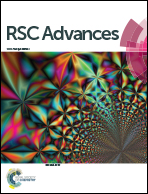Novel fluorescent sensors based on benzimidazo[2,1-a]benz[de]isoquinoline-7-one-12-carboxylic acid for Cu2+†
Abstract
Fluorescent sensors of N-(4-methylpiperazin-1-yl)benzimidazo[2,1-a]benz[de]isoquinoline-7-one-12-carboxylamide (C1) and its corresponding quaternary ammonium salt (C2) were prepared. C1 showed 45-fold fluorescence turn-on response towards Cu2+ with a detection limit of 5.7 × 10−8 mol L−1 in acetonitrile–H2O (9 : 1) buffer solution and C2 showed 18-fold fluorescence enhancement towards Cu2+ with a detection limit of 3.4 × 10−7 mol L−1 in the same condition. The Cu2+ sensing of C1 and C2 were both based on the photoinduced electron transfer (PET) process. Such behaviors confirmed that the benzimidazo[2,1-a]benz[de]isoquinoline-7-one-12-carboxylic acid based C1 and C2 could be utilized as fluorescent sensors for Cu2+. The mechanism of fluorescence enhancement of C1 towards Cu2+ was verified by DFT/TDDFT calculation using Gaussian 03. In addition, an obvious color change was observed when an aqueous solution of C2 was treated with aqueous NaOH. Such behavior confirms that C2 could be used as a fluorescent OH− sensor in water.
![Graphical abstract: Novel fluorescent sensors based on benzimidazo[2,1-a]benz[de]isoquinoline-7-one-12-carboxylic acid for Cu2+](/en/Image/Get?imageInfo.ImageType=GA&imageInfo.ImageIdentifier.ManuscriptID=C4RA12242A&imageInfo.ImageIdentifier.Year=2014)

 Please wait while we load your content...
Please wait while we load your content...